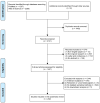A Systematic Review of Oral Biopsies, Sample Types, and Detection Techniques Applied in Relation to Oral Cancer Detection
- PMID: 35822813
- PMCID: PMC9245907
- DOI: 10.3390/biotech11010005
A Systematic Review of Oral Biopsies, Sample Types, and Detection Techniques Applied in Relation to Oral Cancer Detection
Abstract
Background: Early identification of the stage of oral cancer development can lead to better treatment outcomes and avoid malignant transformation. Therefore, this review aims to provide a comprehensive overview that describes the development of standardized procedures for oral sample collection, characterization, and molecular risk assessment. This can help investigators to choose the appropriate sampling method and downstream analyses for different purposes. Methods: This systematic review was conducted according to the PRISMA guidelines. Using both PubMed and Web of Science databases, four independent authors conducted a literature search between 15 and 21 June 2021. We used key search terms to broaden the search for studies. Non-conforming articles were removed using an EndNote-based and manual approach. Reviewers used a designed form to extract data. Results: This review included a total of 3574 records, after eliminating duplicate articles and excluding papers that did not meet the inclusion criteria. Finally, 202 articles were included in this review. We summarized the sampling methods, biopsy samples, and downstream analysis. The biopsy techniques were classified into tissue and liquid biopsy. The common sequential analysis of tissue biopsy includes histopathological examination such as H&E or IHC to identify various pathogenic features. Meanwhile, liquid samples such as saliva, blood, and urine are analyzed for the purpose of screening to detect mutations in cancer. Commonly used technologies are PCR, RT-PCR, high-throughput sequencing, and metabolomic analysis. Conclusions: Currently, tissue biopsies provide increased diagnostic value compared to liquid biopsy. However, the minimal invasiveness and convenience of liquid biopsy make it a suitable method for mass screening and eventual clinical adoption. The analysis of samples includes histological and molecular analysis. Metabolite analysis is rising but remains scarce.
Keywords: biopsy; biospecimen; oral cancer; review.
Conflict of interest statement
The authors declare no conflict of interest.
Similar articles
-
Folic acid supplementation and malaria susceptibility and severity among people taking antifolate antimalarial drugs in endemic areas.Cochrane Database Syst Rev. 2022 Feb 1;2(2022):CD014217. doi: 10.1002/14651858.CD014217. Cochrane Database Syst Rev. 2022. PMID: 36321557 Free PMC article.
-
The Effectiveness of Integrated Care Pathways for Adults and Children in Health Care Settings: A Systematic Review.JBI Libr Syst Rev. 2009;7(3):80-129. doi: 10.11124/01938924-200907030-00001. JBI Libr Syst Rev. 2009. PMID: 27820426
-
Screening for Skin Cancer in Adults: An Updated Systematic Evidence Review for the U.S. Preventive Services Task Force [Internet].Rockville (MD): Agency for Healthcare Research and Quality (US); 2016 Jul. Report No.: 14-05210-EF-1. Rockville (MD): Agency for Healthcare Research and Quality (US); 2016 Jul. Report No.: 14-05210-EF-1. PMID: 27583318 Free Books & Documents. Review.
-
Ethics of Procuring and Using Organs or Tissue from Infants and Newborns for Transplantation, Research, or Commercial Purposes: Protocol for a Bioethics Scoping Review.Wellcome Open Res. 2024 Dec 5;9:717. doi: 10.12688/wellcomeopenres.23235.1. eCollection 2024. Wellcome Open Res. 2024. PMID: 39839977 Free PMC article.
-
Dietary glycation compounds - implications for human health.Crit Rev Toxicol. 2024 Sep;54(8):485-617. doi: 10.1080/10408444.2024.2362985. Epub 2024 Aug 16. Crit Rev Toxicol. 2024. PMID: 39150724
Cited by
-
Evaluation of Usage of Different Diagnostic Aids for Oral Cancer by Oral and Maxillofacial Surgeons: An Original Research.J Pharm Bioallied Sci. 2024 Feb;16(Suppl 1):S272-S275. doi: 10.4103/jpbs.jpbs_489_23. Epub 2024 Feb 29. J Pharm Bioallied Sci. 2024. PMID: 38595614 Free PMC article.
-
Oral mucosa - an examination map for confocal laser endomicroscopy within the oral cavity: an experimental clinical study.Clin Oral Investig. 2024 Apr 23;28(5):266. doi: 10.1007/s00784-024-05664-9. Clin Oral Investig. 2024. PMID: 38652317 Free PMC article.
-
Oral squamous cell carcinoma vs. medication-related osteonecrosis of the jaw in patients assuming bone-modifying agents: a diagnostic challenge in a multi-hospital case series.Front Oral Health. 2025 Jun 12;6:1574425. doi: 10.3389/froh.2025.1574425. eCollection 2025. Front Oral Health. 2025. PMID: 40575659 Free PMC article.
-
Use of Cysteamine and Glutaraldehyde Chemicals for Robust Functionalization of Substrates with Protein Biomarkers-An Overview on the Construction of Biosensors with Different Transductions.Biosensors (Basel). 2022 Jul 29;12(8):581. doi: 10.3390/bios12080581. Biosensors (Basel). 2022. PMID: 36004978 Free PMC article. Review.
-
Imaging Biomarkers of Oral Dysplasia and Carcinoma Measured with In Vivo Endoscopic Optical Coherence Tomography.Cancers (Basel). 2024 Aug 2;16(15):2751. doi: 10.3390/cancers16152751. Cancers (Basel). 2024. PMID: 39123478 Free PMC article.
References
-
- García-Martín J.M. Epidemiology of Oral Cancer. In: Panta P., editor. Oral Cancer Detection: Novel Strategies and Clinical Impact. Springer International Publishing; Cham, Switzerland: 2019. pp. 81–93.
Publication types
Grants and funding
LinkOut - more resources
Full Text Sources

